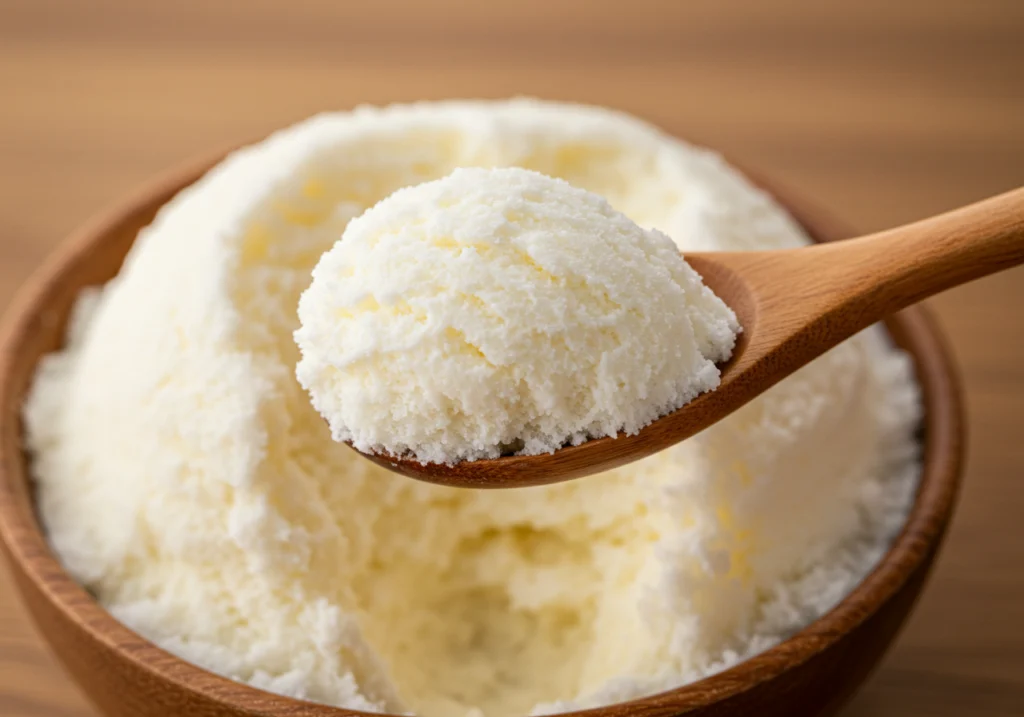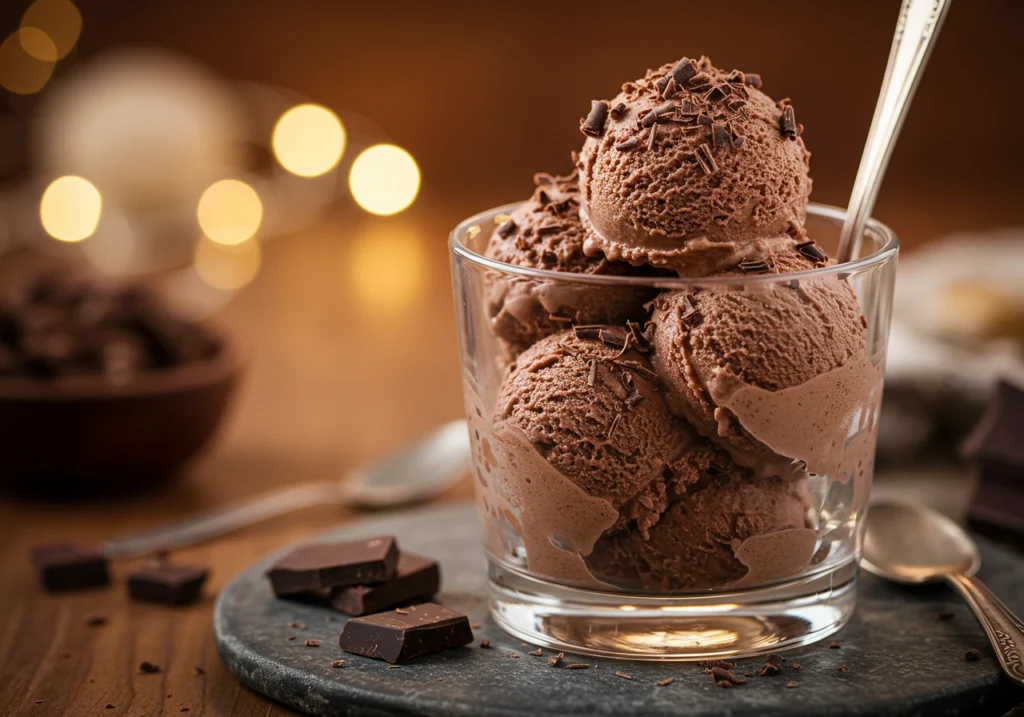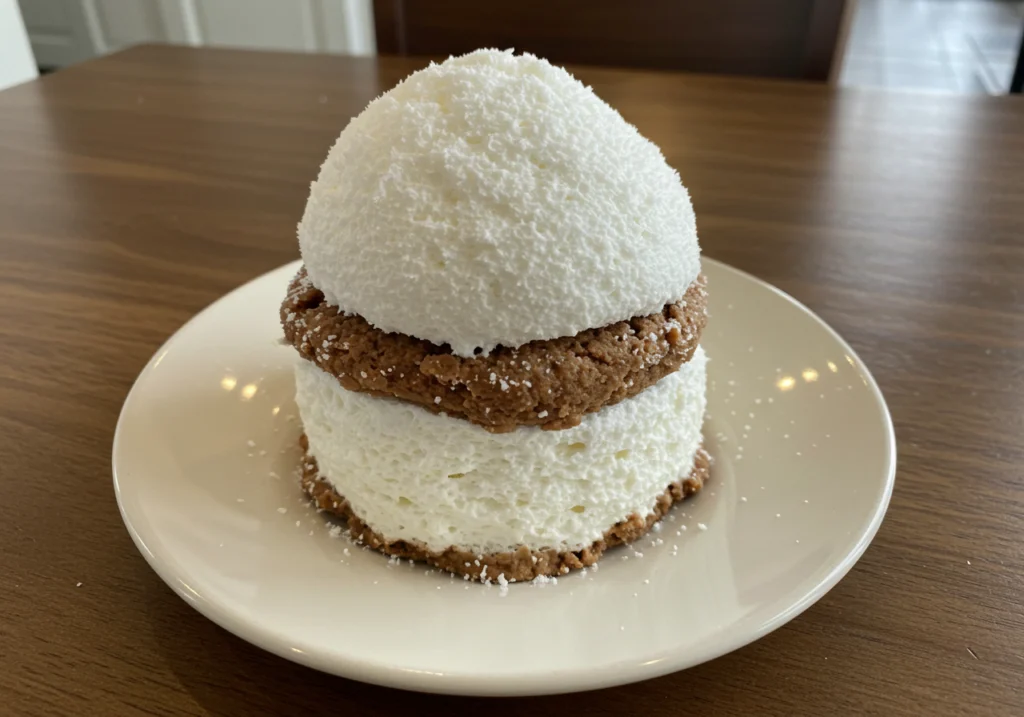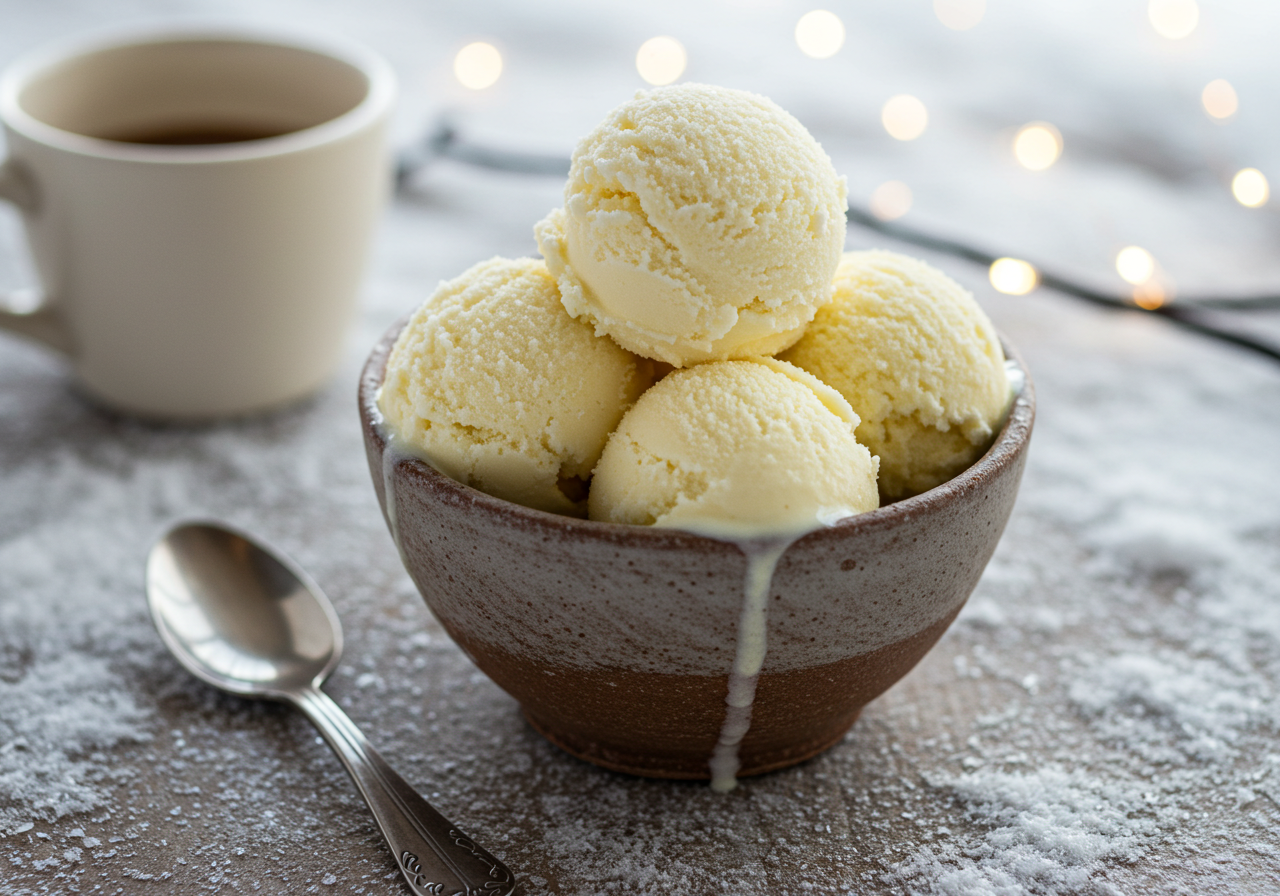Introduction
Nothing screams winter wonderland quite like a fresh snowfall, and what better way to celebrate than by whipping up a batch of homemade snow cream? This nostalgic treat, made from freshly fallen snow and a few simple pantry ingredients, has been a beloved tradition in snowy regions for generations. Whether you’re making it for the first time or reliving childhood memories, this guide will walk you through everything you need to know—from selecting the right snow to experimenting with flavors and dietary alternatives.
But before we dive in, let’s clear up a common question: Is it safe to eat snow? The short answer—yes, if you follow a few simple precautions, which we’ll cover. Now, grab a bowl, bundle up, and let’s make some delicious snow cream!
Part 1: Introduction to Snow Cream Recipe
What is Snow Cream Recipe?
If you’ve never heard of snow cream, you’re in for a treat! Unlike traditional ice cream, which requires churning and freezing, snow cream is a no-fuss dessert made by mixing fresh snow, milk (or cream), sugar, and vanilla extract. The result? A light, fluffy, and slightly sweet frozen delight that melts in your mouth.
But where did this winter delicacy come from? The origins of snow cream can be traced back centuries. Historical records suggest that ancient civilizations, such as the Chinese and Romans, enjoyed a version of snow-based desserts by mixing snow with honey, fruits, or dairy. Fast forward to today, and the tradition has evolved into a fun, family-friendly activity whenever the snow falls.
The Allure of Snow Cream
There’s something undeniably magical about making snow cream. Unlike store-bought ice cream, which is available year-round, snow cream is a seasonal delight—meaning you only get to enjoy it when Mother Nature decides to grace us with fresh snowfall. This exclusivity makes it all the more special!
Plus, it’s ridiculously easy to make. You don’t need any fancy ice cream machines, just a bowl of fresh snow, a few ingredients, and a spoon to mix it all together. The simplicity of this recipe means it’s perfect for kids and adults alike.
And let’s be real—what’s better than eating snow? Instead of just watching it pile up outside, you can turn it into a delicious, creamy treat. Sounds like a win-win, doesn’t it?
Is Snow Safe to Eat? A Quick Safety Guide
Before we dive into the recipe, let’s address a crucial question: Can you really eat snow? The answer is yes—with some caveats.
Pick Fresh Snow – The best snow for snow cream is freshly fallen, ideally within the first hour of a snowfall. Avoid snow that has been sitting for too long, as it may have collected pollutants.
Avoid the First Snowfall – The first snowfall of the season tends to carry more contaminants from the air. If possible, wait for the second or third snowfall.
Go for the Top Layers – Never scoop up the snow from the bottom where it touches the ground. Instead, collect from the top layers.
Watch Out for Discoloration – This should go without saying, but never eat yellow snow (or any snow with a strange tint).
Urban vs. Rural Areas – If you live in a busy city with lots of pollution, snow might not be the best option for consumption. In contrast, rural or suburban areas with less pollution generally have cleaner snowfall.
By following these precautions, you can enjoy your snow cream safely without worrying about unwanted contaminants.

Why You Should Try Making Snow Cream Recipe This Winter
Still not convinced? Here are a few reasons why you should give snow cream a shot this winter:
- It’s a fun family activity – Kids love gathering snow and mixing it up with their favorite flavors.
- It’s customizable – You can get creative with mix-ins, from chocolate chips to fresh fruit or even a drizzle of maple syrup.
- It’s a budget-friendly dessert – No need for expensive ice cream makers or store-bought treats—this one’s practically free!
- It’s naturally low in calories – Unlike traditional ice cream, which is loaded with heavy cream and eggs, snow cream can be made lighter by using milk alternatives.
With all these reasons, it’s hard to resist the temptation of making your own homemade snow cream!
Part 2: Essential Ingredients for Snow Cream Recipe
Making the perfect snow cream starts with the right ingredients. While the process is simple, using quality ingredients ensures the best flavor and texture. The most crucial component? Fresh snow—but that’s just the beginning!
Let’s dive into the must-have ingredients and how each one plays a role in creating this delightful winter treat.
Fresh Snow
Collecting Clean Snow
The magic of snow cream lies in its light and fluffy texture, which comes directly from freshly fallen snow. However, not all snow is created equal! Here’s how to safely collect snow for the best results:
Wait for a steady snowfall – The first flakes might not be the cleanest, as they gather pollutants from the air. Wait until it’s been snowing for at least 30 minutes before collecting.
Use a clean container – Avoid scooping snow off the ground or any surface that may have contaminants. Instead, place a large mixing bowl or baking sheet outside to catch freshly falling snow.
Go for the top layer – If you’re gathering from an already fallen layer, always skim the top few inches. Avoid snow that’s near roads, driveways, or sidewalks where it might be tainted with salt and dirt.
Keep it cold – Once you’ve gathered your snow, store it in the freezer until you’re ready to use it. Snow melts fast indoors, so keeping it chilled ensures the right consistency.
Safety Considerations
While snow cream is a fun and safe treat when made correctly, here are a few safety tips to keep in mind:
Avoid colored snow – Any snow that looks yellow, brown, or gray is a no-go! Even if it appears clean, discoloration often signals contamination.
Be mindful of city pollution – If you live in a densely populated area with heavy traffic, the snow may contain pollutants from vehicle exhaust. Rural areas typically have cleaner snowfall.
Don’t use old snow – If it’s been sitting outside for hours, it’s more likely to have absorbed dirt and pollutants from the air. Fresh snow is always best.
By following these precautions, you can enjoy snow cream without any worries!
Dairy Components
Once you have your fresh snow, the next key ingredient is a creamy liquid. This is what gives snow cream its smooth texture. Let’s explore the different dairy and non-dairy options you can use.
Milk Options
Whole Milk – A classic choice that creates a light and refreshing texture while maintaining a mild sweetness.
Heavy Cream – If you prefer a rich and decadent snow cream, using heavy cream will add an extra layer of creaminess.
Sweetened Condensed Milk – This is a game-changer! It’s already sweetened, which means you don’t need extra sugar. Plus, it gives the snow cream a smooth and velvety consistency.
Evaporated Milk – A great option if you want a creamier texture but without the extra sweetness of condensed milk.
Half-and-Half – A balance between whole milk and heavy cream, providing a lighter yet still creamy finish.
For a more authentic old-fashioned taste, many Southern-style snow cream recipes use sweetened condensed milk instead of sugar and regular milk. It’s rich, flavorful, and super easy to mix in!
Vegan Alternatives
If you’re dairy-free or vegan, don’t worry—snow cream can still be yours! Here are some fantastic plant-based options:
🌱 Almond Milk – A light alternative that adds a mild, nutty flavor.
🥥 Coconut Milk – Want a tropical twist? Coconut milk (especially full-fat) makes snow cream extra creamy.
🌱 Oat Milk – A naturally sweet, thicker plant milk that pairs beautifully with vanilla flavoring.
🥛 Cashew or Macadamia Milk – These creamy nut-based options mimic the richness of dairy without overpowering the flavor.
🌱 Soy Milk – A versatile choice that blends well with other flavors.
For the creamiest vegan version, try using coconut cream or blending cashews into cashew milk for a richer texture.
Sweeteners
A little sweetness is essential for snow cream! While many traditional recipes use granulated sugar, there are plenty of other options to explore.
Traditional Sugars
🍚 White Sugar – The most common option, giving snow cream a neutral sweetness without altering the texture.
🌾 Brown Sugar – Adds a slight caramel-like depth to the flavor.
🍁 Maple Syrup – A natural sweetener that pairs beautifully with vanilla and cinnamon. Perfect for a cozy winter twist!
🍯 Honey – A healthier, natural alternative that brings a light floral sweetness.
🌿 Stevia or Monk Fruit – If you want to keep your snow cream low in sugar, these natural sweeteners work well in small amounts.
Flavor Enhancers
The magic of snow cream doesn’t just come from its creamy texture—it’s also about the flavors you add. Here are some essential flavor boosters:
🍦 Vanilla Extract – A must-have! It enhances the flavor and gives snow cream that classic vanilla bean taste.
🍫 Cocoa Powder – Want chocolate snow cream? Stir in cocoa powder for a rich, chocolaty treat.
🍓 Fruit Juices or Purees – Add fresh strawberry puree, orange zest, or even blueberry syrup for a fruity twist!
🥥 Coconut Extract – If you’re using coconut milk, a splash of coconut extract will enhance the tropical flavor.
🍋 Lemon or Almond Extract – A few drops of these extracts can completely transform the taste!
🧂 Pinch of Salt – A tiny pinch of salt helps balance the sweetness and enhances the overall flavor.
Part 3: Step-by-Step Guide to Making Snow Cream Recipe
Now that we’ve covered the essential ingredients, it’s time for the most exciting part—actually making snow cream! The beauty of this recipe is its simplicity—no fancy equipment or complicated steps required. Just a few ingredients, a little bit of mixing, and voilà! You’ll have a fluffy, creamy, and delicious frozen treat in no time.
Let’s break it down step by step.
Preparation Steps
Gathering Ingredients
Before you start, make sure you have everything you need. Here’s a quick checklist of essentials:
🛒 Ingredients:
6–8 cups of freshly fallen snow (more or less, depending on your desired consistency)
1 cup milk, cream, or dairy alternative (whole milk, sweetened condensed milk, or coconut milk work great)
¼–½ cup sugar, maple syrup, or honey (adjust to taste)
1–2 teaspoons vanilla extract (for that classic flavor)
Optional: cocoa powder, fruit puree, or extracts for flavor variations
🛠 Tools Needed:
A large mixing bowl (big enough to hold the snow and mix easily)
A wooden spoon or silicone spatula for stirring
A measuring cup for precise ingredient portions
An ice cream scoop (optional, but makes serving easier!)
💡 Pro Tip: Since snow melts quickly, it’s best to gather it right before mixing or store it in the freezer until you’re ready to use it.

Mixing Process
Now, let’s get to the fun part—mixing everything together! Follow these steps for the perfect snow cream:
Scoop Fresh Snow into a Bowl
- Collect 6–8 cups of light, fluffy snow in a clean mixing bowl. If the snow is packed or icy, you may need less.
Add the Liquid Ingredients
- Pour in 1 cup of your chosen dairy or dairy-free milk.
- Stir gently to avoid deflating the snow.
Sweeten to Taste
- Add ¼ cup of sugar (or more if you like it sweeter).
- Stir in 1 teaspoon of vanilla extract for extra flavor.
- If you’re using maple syrup or honey, drizzle it evenly over the snow before mixing.
Stir Gently
- Use a wooden spoon or spatula to fold the ingredients together.
- Don’t overmix—it should be creamy but still fluffy!
Adjust Consistency
- If the mixture is too dry, add more milk one tablespoon at a time.
- If it’s too runny, just add a little more snow.
Flavor Variations (Optional)
- For chocolate snow cream, mix in 2 tablespoons of cocoa powder.
- Want a fruity twist? Add pureed strawberries or a splash of orange juice.
- Experiment with cinnamon, almond extract, or coconut flakes for extra fun!
Serve Immediately
- Snow cream melts fast, so dish it up as soon as it reaches the perfect consistency!
Serving Suggestions
Now that you’ve made your snow cream, let’s make it look as amazing as it tastes!
Presentation Tips
🍨 Use Fun Bowls – Serve your snow cream in a chilled glass or a colorful ceramic bowl for extra appeal.
🍽 Layer it Up – Make a snow cream sundae by layering it with fresh fruit, whipped cream, and toppings.
🎨 Drizzle & Swirl – A drizzle of chocolate syrup, honey, or berry coulis can make it restaurant-worthy.
🍦 Scoop Like a Pro – Use an ice cream scoop to form perfect, round servings.
Toppings to Elevate Your Snow Cream Recipe
The best part about snow cream? You can customize it to your heart’s content! Here are some delicious topping ideas:
Chocolate Chips or Cocoa Nibs – For a rich and crunchy texture.
Fresh Fruit – Strawberries, bananas, or blueberries add a natural sweetness.
Caramel or Honey Drizzle – Perfect for an extra layer of indulgence.
Chopped Nuts – Walnuts, almonds, or pecans add a satisfying crunch.
Sprinkles or Crushed Cookies – Because who doesn’t love a little extra fun?
Part 4: Variations of Snow Cream Recipe
While classic vanilla snow cream is undeniably delicious, why stop there? One of the best things about snow cream is how versatile it is. With just a few extra ingredients, you can create a variety of flavored, healthier, and dietary-friendly versions to suit your taste and lifestyle.
From rich chocolatey goodness to bright, fruity delights, let’s explore how you can put a unique spin on this winter treat!
Flavor Infusions
If you love experimenting in the kitchen, these flavor-infused snow creams will take your snow dessert to the next level!
Chocolate Snow Cream Recipe
🍫 Love chocolate? You’re in for a treat! By adding cocoa powder or chocolate syrup, you can create a decadent chocolate-flavored snow cream.
How to Make It:
- Start with the classic snow cream recipe.
- Add 2 tablespoons of unsweetened cocoa powder to the sugar before mixing.
- Stir in a drizzle of chocolate syrup for extra richness.
- Top with chocolate chips or crushed cookies for even more texture!
💡 Pro Tip: Want a mocha twist? Add ½ teaspoon of instant coffee powder for a bold, coffee-infused flavor.
Fruit-Flavored Snow Cream Recipe
🍓 Berry Bliss – Blend in strawberry, raspberry, or blueberry puree for a naturally sweet and colorful treat.
🍊 Citrus Delight – Add fresh-squeezed orange or lemon juice for a refreshing tang.
🍍 Tropical Twist – Mix in pineapple juice and coconut extract for a beachy vibe (even in the snow!).

How to Make It:
- Replace ½ cup of milk with your favorite fruit puree or juice.
- Stir it in gently to keep the snow fluffy.
- Garnish with fresh fruit slices or a drizzle of honey for extra sweetness.
💡 Pro Tip: A dash of cinnamon or nutmeg can enhance fruit flavors beautifully!
Dietary Modifications
If you’re looking for healthier options or have dietary restrictions, don’t worry—there’s a snow cream recipe for everyone!
Sugar-Free Options
If you’re cutting back on sugar, you can still enjoy snow cream by using natural or low-calorie sweeteners.
Honey or Maple Syrup – Natural alternatives with a hint of added flavor.
Stevia or Monk Fruit Sweetener – Zero-calorie options that blend well.
Unsweetened Almond or Coconut Milk – Already slightly sweet, reducing the need for added sugar.
💡 Pro Tip: If using stevia, start with a small amount and adjust to taste—it’s much sweeter than sugar!
Dairy-Free Alternatives
Going dairy-free doesn’t mean you have to skip snow cream! These milk substitutes create a rich, creamy texture without dairy:
🥥 Coconut Milk – Adds a tropical, creamy feel and pairs perfectly with vanilla or chocolate.
🌱 Almond Milk – A light alternative with a mild, nutty taste.
🥛 Oat Milk – Thick and naturally sweet, great for those avoiding nuts.
🌰 Cashew Milk – Extra creamy, perfect for a rich texture.
💡 Pro Tip: If you want a thicker consistency, blend in a mashed banana before mixing with the snow.
Part 5: Historical and Cultural Context
Snow Cream Recipe might seem like a modern-day winter novelty, but its roots trace back centuries. Across cultures and generations, the idea of mixing snow with sweeteners and dairy has been a delightful way to enjoy nature’s seasonal gift. From ancient emperors indulging in snow-based treats to today’s viral TikTok snow cream trends, let’s take a journey through the history and evolution of this beloved dessert.
Origins of Snow Cream Recipe
Early Mentions
Snow has been used as an ingredient in frozen desserts for thousands of years. Some of the earliest records suggest that:
📜 Ancient China (200 BCE) – Chinese royalty enjoyed a snow and fruit mixture, similar to modern sorbets. They would mix fresh mountain snow with honey and fruit juices, creating an early version of snow cream.
🏺 Ancient Rome (First Century CE) – Roman Emperor Nero reportedly sent slaves to the Alps to collect fresh snow, which he flavored with honey and fruit. This luxurious treat was only available to the elite.
🌍 Middle Eastern Variations – The Persians made a similar dessert, called Sharbat, by combining ice or snow with fruit syrups and spices. This method later influenced Italy’s development of granita.
🍦 Colonial America (1700s-1800s) – Early American settlers, particularly in New England and the Appalachian region, are believed to have developed snow cream by combining fresh snow with milk, sugar, and vanilla. This version became popular among families as a fun and easy way to make homemade ice cream during the winter months.
Geographical Popularity
Over time, snow cream became a cherished regional tradition in areas with cold winters and heavy snowfall. Some of the best-known snow cream regions include:
🏔 The Appalachian Mountains (USA) – One of the most famous areas for snow cream, where families have passed down homemade recipes for generations.
🌨 Canada & Northern US States – Areas with long, snowy winters, like Minnesota, Maine, and Vermont, have embraced snow cream as a fun seasonal tradition.
🇯🇵 Japan – Japanese shaved ice desserts, known as kakigori, share similarities with snow cream, often featuring condensed milk and sweet syrups.
🇮🇹 Italy – Italian granita, a semi-frozen dessert made with ice, fruit, and sugar, is reminiscent of early versions of snow cream.
🇰🇷 Korea – Bingsu, a Korean shaved ice dessert, uses sweetened condensed milk and toppings similar to snow cream.
While each region has its own take on frozen treats, the concept of snow cream—enjoying nature’s ice cream straight from the sky—remains timeless!
Snow Cream in Modern Times
Resurgence of Snow Cream Recipe
For a while, snow cream was mainly enjoyed as a nostalgic, family tradition in colder regions. However, in recent years, it has made a comeback—especially in the world of homemade, nostalgic, and natural food trends.
Growing Interest in Simple, DIY Desserts – As more people embrace homemade and minimal-ingredient recipes, snow cream fits perfectly into this trend.
Health & Allergy-Friendly Variations – With the rise of vegan, dairy-free, and sugar-free options, snow cream has been adapted to suit various dietary needs.
Eco-Friendly Appeal – Many people enjoy snow cream as an eco-conscious alternative to store-bought ice cream, using only fresh snow and pantry staples.
Social Media Influence
With the rise of TikTok, Instagram, and YouTube, snow cream has become an internet sensation. Millions of people have rediscovered the joy of making snow-based treats, thanks to viral videos showcasing:
“Snow Cream Challenges” – Social media users race to see who can make the best snow-based dessert with unique flavors and toppings.
Aesthetic & ASMR Appeal – Watching fluffy snow being mixed into creamy goodness is oddly satisfying, making it perfect for viral content.
Global Sharing of Recipes – People worldwide have shared cultural variations of snow cream, from chocolate-infused versions to fruit-based snow desserts.
From ancient emperors to modern-day TikTokers, snow cream has evolved while keeping its whimsical and nostalgic charm intact.

Part 7: Frequently Asked Questions (FAQs)
Even though snow cream is a simple and fun dessert, people still have plenty of questions about it—especially when it comes to ingredients, regional traditions, and safety. Below, we’ll tackle some of the most common FAQs to help you enjoy this winter treat with confidence!
What is Snow Cream Made Of?
At its core, snow cream is a quick and easy homemade ice cream made from fresh snow, milk (or a dairy-free alternative), sugar, and vanilla extract. These basic ingredients blend together to create a light, fluffy, and creamy frozen treat that melts in your mouth.
However, snow cream can be customized in endless ways! Some people like to add:
Sweetened condensed milk for extra richness
Cocoa powder for a chocolate version
Maple syrup or honey instead of sugar
Fruit juice or purees for a fruity twist
Toppings like sprinkles, nuts, or chocolate chips
The beauty of snow cream is that it’s versatile, fun, and super easy to make—a perfect winter tradition for the whole family!
Is Snow Cream Recipe Just a Southern Thing?
Not at all! While snow cream is widely popular in the Southern U.S., especially in Appalachia, it’s enjoyed in many snowy regions worldwide.
In New England and the Midwest, families have long made snow cream on snow days.
Canada has a similar tradition with maple taffy (tire d’érable)—hot maple syrup poured over snow!
In Japan and Korea, shaved ice desserts like kakigori and bingsu share similarities with snow cream.
So while it’s strongly associated with the South, snow cream is a beloved treat in many winter-loving cultures!
How Do You Make Snow Cream Recipe in Appalachia?
Appalachian snow cream is one of the most authentic and time-honored versions of this treat. Families in the region have passed down recipes for generations, often keeping it simple and sweet.
Here’s a classic Appalachian Snow Cream Recipe:
6–8 cups of fresh snow
1 cup of milk (or sweetened condensed milk for extra creaminess)
½ cup of sugar
1 teaspoon vanilla extract
🔹 How to Make It:
Scoop clean, freshly fallen snow into a large mixing bowl.
Add sugar and vanilla extract first, then pour in milk.
Stir gently until everything is well combined and creamy.
Serve immediately, or store briefly in the freezer to firm up.
Some families add cocoa powder, cinnamon, or maple syrup, but the classic version is always simple, creamy, and nostalgic!
Is It Safe to Make Snow Ice Cream Now?
Yes! But it’s important to follow a few safety guidelines to ensure your snow cream is clean and safe to eat.
Collect fresh, newly fallen snow – The first snowfall of the season can contain more pollutants, so wait for a later snow if possible.
Avoid snow near roads and sidewalks – These areas may contain dirt, salt, or chemicals.
Scoop from the top layers – Snow near the ground may have picked up bacteria or debris.
Watch out for discolored snow – Never use yellow, gray, or oddly colored snow.
If you’re concerned about contaminants, you can boil the milk first before adding it to your snow cream or use a snow alternative like shaved ice.
For most people in areas with clean snowfall, snow cream is perfectly safe when made with care and common sense!


1 thought on “Delicious & Easy Snow Cream Recipe: A Winter Treat for All!”